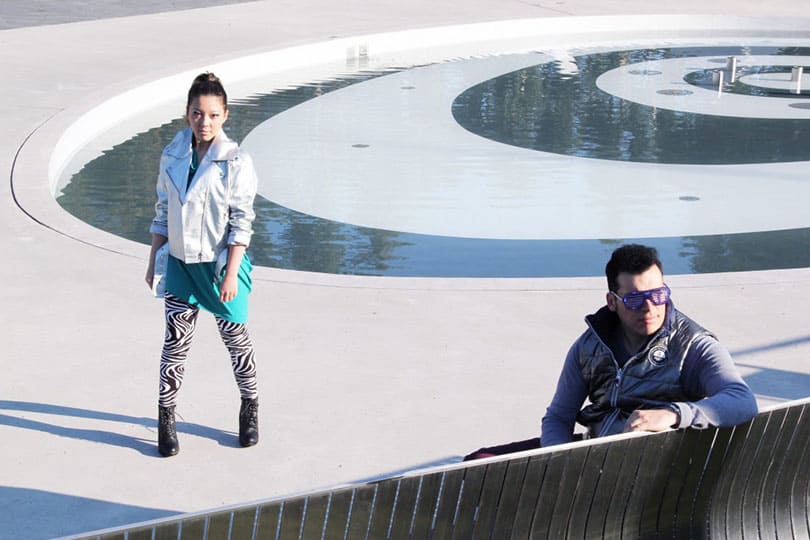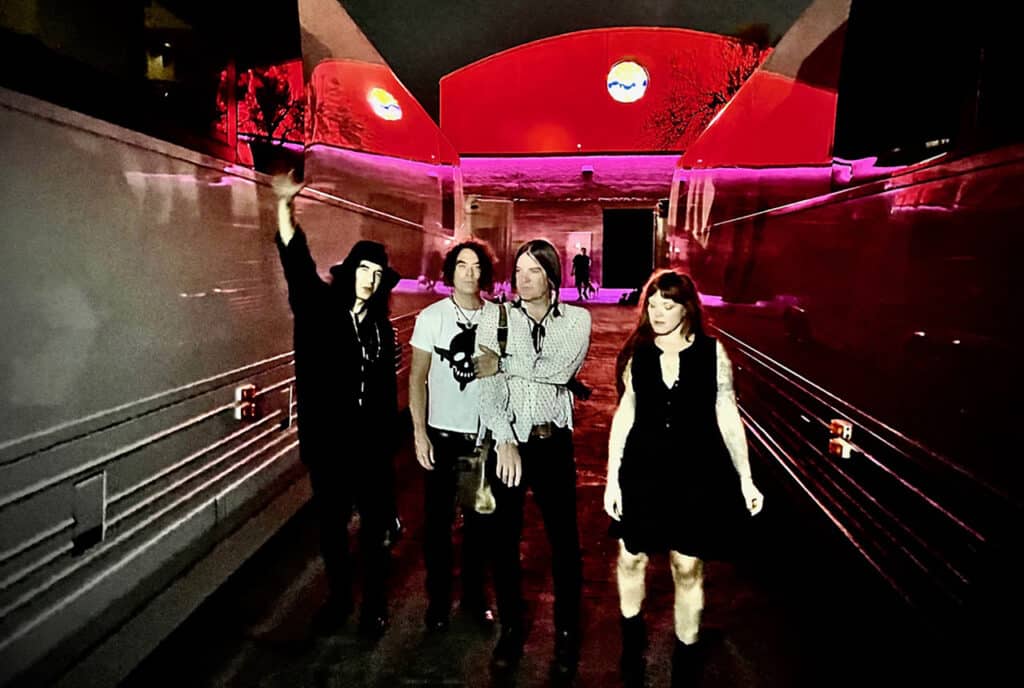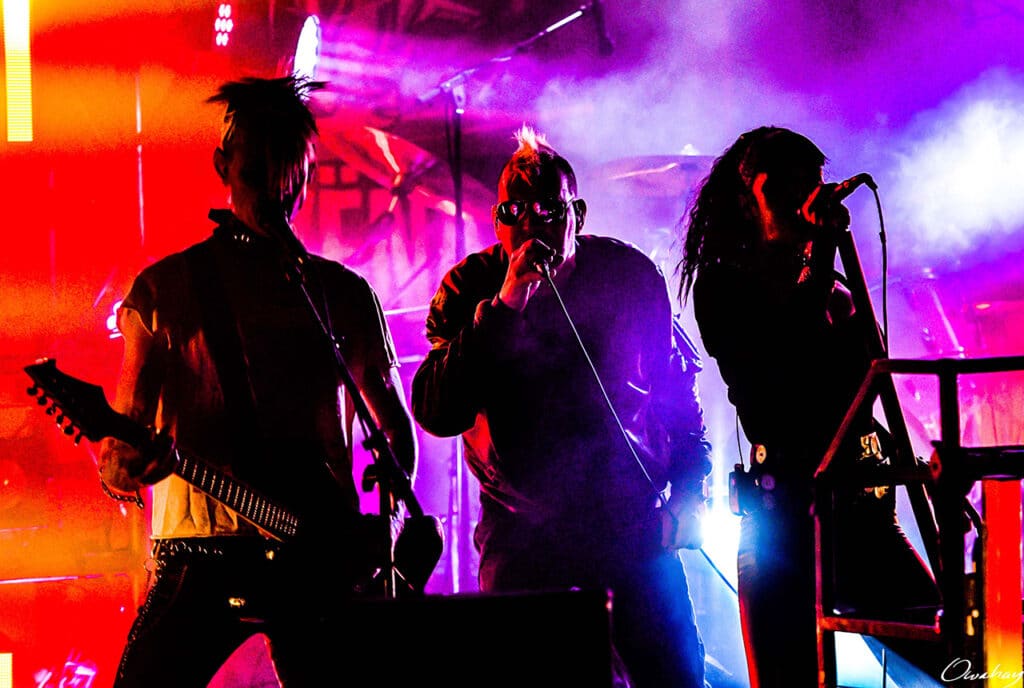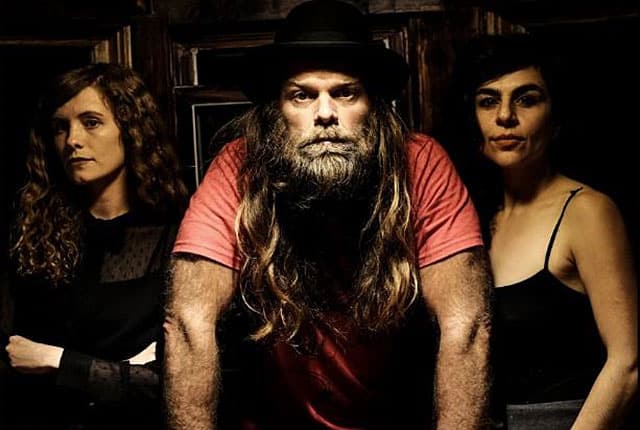Based in Düsseldorf, Emotikon are a German-Japanese duo who combine a heavy influence of classic synth pop with touches of ethereal and world beat music. Comprised of vocalist Mine and electronic musician Tom Tron, the group has yet to play live, but they have unleashed several highly imaginative music videos onto the web. In the following email interview, the group talks about their creative process, technology, and more.
I see in your bio that Mine is a trained musical theater actress and Tom is a video game composer, but could you elaborate a bit on particular projects you’ve been involved with?
MINE: I studied singing and dancing at a musical theater school in Hamburg. I didn’t actually get to work on productions, since we founded “Emotikon” right after I finished my studies. I had to choose between a relatively safe job and starting a band, and I just jumped into the deep end.
TOM: I’ve composed music for video games using my real name, mostly low-budget and casual games. Although I did one bigger title for Activision, and another title for JoWood, a major European games publisher, which were released world-wide and sold quite well. It was fun and helped me to develop my composing skills, but I’ve really always wanted to get into songwriting at some point.
What motivated you to start creating music together?
MINE: Starting a band gets you a little more attention than being part of a larger and slightly more anonymous ensemble.
TOM: 80s bands like “Eurythmics” and the “Pet Shop Boys” had a huge influence on me, and those were duos. For whatever reason, I think that this constellation is perfect for a synthpop act. That’s why I started looking for a pretty girl who can sing.
MINE: When we first met, we had no idea where we were heading. Tom had a lot of songs prepared, he had collected ideas for years. It took us some weeks to come up with a concept, to define who we are and where we want to go.
TOM: Meeting Mine was quite inspiring. The fact that she’s of Asian ancestry put a whole new spin on the project. The name, the sound and the band image were all affected by this. And we just happened to get along with each other very well.
What is the creative process like within the band?
TOM: I write the songs, both the music and the lyrics. Then Mine listens to my demos and tears them to shreds.
MINE: Some of the original drafts of the album’s songs didn’t fit my vocal range very well. They needed to be adapted. That’s not “tearing to shreds”.
TOM: No, it’s just rewriting. Which is part of the process. I was used to writing instrumental music and working with a singer was something completely new for me. But I learned a lot in the process.
Do you ever consider the environments in which your music will be listened to? For example, perhaps nuances in the production come through more on headphones vs listening on speakers, and of course hearing something in a club vs at home can be a very different experience.
TOM: Listening to your music under different circumstances is an important part of the mastering process. When you hear it in your car, for example, the engine noise takes away a lot of bass and mid-range frequencies, depending on how fast you go. Small headphones can completely cut off the bass. Large headphones, however, may have a very bassy sound that diminishes the treble. The most important thing is that the songs sound right on your studio speakers, which usually have a very neutral sound and an immense range of loudness.
MINE: Although you can’t crank them up all the way, or your neighbors would kill you.
TOM: Exactly. I’m dreaming of a studio in a remote country house with no neighbors but squirrels.
What are your long-terms goals for releasing your music? Are you looking to sign to a label, or continue to release things yourself? If looking for a label, what are your criteria, given the current state of the music industry?
TOM: Right now wer’re an unsigned band, and we’re quite happy with it. It means a lot of work for us, since we have to do everything ourselves, but the fact that we keep complete creative control makes up for the hassle.
MINE: The problem with the music industry is that it kind of has a really bad rep right now. It’s not even “cool” to get signed these days. The public perceives the industry as some kind of soulless machinery that churns out mindless drivel, forces horrible casting shows on TV viewers and exploits its artists. The internet however is a great tool to present ourselves. We get a lot of feedback from fans, we’re close to the people who love our music. I think we have all we need.
TOM: The path we’ve chosen is certainly longer and harder, but we haven’t regretted it yet. If a label made us an offer, we’d still always be willing to sit down and talk. It all depends on the details, really.
Could you describe your main instrumentation? Are there particular pieces of equipment or software that you feel are particularly important to your sound and/or creative process?
TOM: Almost all of the instruments used are VST plug-ins in Cubase. Some of them real-time synths, some of them samples. The electric guitar used for the solo on “Where Are You From?” is from EastWest’s “Ministry of Rock” library, for example. A few lead sounds, however, come from an old Korg Prophecy synthesizer, which I bought used. It’s a great machine but unfortunately monophonous. The synth line at the beginning of “When Does My Life Begin?” was done with the Prophecy, for example. I want to use it more often in the future. It sounds better than any plug-in, for sure.
MINE: The only “real” instrument used is a cello. You can hear it on the opening track as well as on “Walk Among the Clouds”. Lilian Mann joined us in the studio, she’s a very accomplished cello player. You can also see her performing in the “Clouds” video.
TOM: And I used a lot of samples from the Commodore 64’s SID soundchip. I just love the rough, dirty sound of it. It’s great to spice things up and if you listen closely, you’ll feel its influence throughout the whole album.
Do you perform live at all? If so, is it just the two of you, or do you use additional musicians?
MINE: No, we haven’t performed live yet. We’d love to, but right now, we simply can’t. I’ve pursued my acting career and last January, I got offered a lead role in a major German soap opera. It was an offer that I couldn’t refuse, even if it meant that I’d have less time for the band.
TOM: Mine is shooting episodes for the show almost every day, sometimes even on week-ends. There’s just no time to design and rehearse a stage show. But who knows – maybe we’ll actually do live gigs at some point. Never say never. We certainly can’t do it as long as we have to work other jobs to make a living.
How much of your sound/style do you think comes about of conscious decisions vs just being the result of music you like/are influenced by? To what degree might you do things specifically to sound different from other acts?
TOM: It’s very important for me to point out that originality plays a key role for us. Although we’re a kind of retro band which is clearly inspired by classic 80s synthpop, we put a lot of emphasis on developing our own style. We take pride in the fact that we’re not copying the songs or the image of those who came before us.
MINE: We did a few tests with friends and relatives and played the album to them before it was released. We asked them what the music reminded them of. Most of them said something like “the 80s in general” or “early 90s dance music”, but none of them said “you sound exactly like Depeche Mode here” or “you ripped off UltraVox there”. Which made me very proud.
TOM: What I simply don’t understand about the music industry is why stealing and copying is so popular. I mean, when you’ve finally got the chance to present yourself as an artist, why would you lift lyrics or melodies from someone else’s work? To me, it contradicts the whole idea of being an artist.
MINE: The music industry is not about art, it’s simply about selling stuff. And it steals because it’s easier to sell something that’s tried and tested. That’s why Hollywood is only doing remakes and reboots of older movies now – which is kind of sad and confusing. It feels like everything has been done and we’re walking in circles.
TOM: I do still believe that it’s very much possible to come up with fresh song ideas and sounds. Originality is not dead, and we’ll keep fighting to prove this. And I think there’s a real demand for it, too. People are kind of tired of what the industry offers them, that’s why SoundCloud has become so popular – listeners want to discover new stuff.
I saw the video that you did in the musical/visual style of the Commodore 64 computer. Is there any current technology that you think people 30 years from now might look back upon the same way?
MINE: We just released another one in this style, because we love it, and the fans seem to dig it, too!
TOM: People like to look back at the “digital stone age” because those machines were so primitive by today’s standards, yet the programers would come up with a lot of tricks to do awesome stuff with them. Back then, it was all about ideas and trying out things. Computers are not exciting anymore, they’re just tools we employ on a daily basis without thinking much.
MINE: Artists have discovered the very unique aesthetics of the 8-bit era as a tool of expression. The low screen resolution and the odd sound chips are embraced today instead of ridiculed, like they were, say, 15 years ago. And it’s their imperfection, their narrowness, that makes them interesting. It’s much more challenging to draw a great picture using only 16 colours instead of 24 million.
TOM: Limiting your options can actually result in artistic motivation. Sometimes, less is more. Renaissance painters didn’t have Photoshop, they only had a canvas and a greasy palette, but much of their work is still unmatched. Why? Because drive and talent matter more than technology in the long run.
Could you discuss your videos a bit? Do you see them as an extension of the music, or just tools to get online exposure? Do you ever start to plan the video while working on a song?
TOM: If we only regarded them as tools, we could have made things easier for us by just performing in front of a webcam with bad lighting and odd camera angles, like so many people do. Nothing wrong with that, but we’re a little more amibitious. Maybe that’s because I studied film, and the art of the moving image means a lot to me personally. In a way, “Emotikon” didn’t just enable me to become a songwriter, it also allowed me to try out things as a filmmaker.
MINE: We started thinking about the videos early on. In fact, there were cases when the idea for the video existed before the song was even written. For example, we noticed that nobody had done a music video involving the celebrity heads on money bills before. We thought, “what about making them come to life?”
TOM: I had found this piece of facial animation software called “CrazyTalk” online. This is how we got the idea for “Money Isn’t Everything”. The actual song was written much later, after I’d even done the first animation tests.
MINE: It’s so much fun to do videos. I wish we had a higher budget for them! The ones we did almost cost nothing, because we did everything ourselves or asked friends to help us. But limited means force you to be inventive.
TOM: Yes, we’re very fortunate to know other artists who volunteered to support us. Steffen Troeger, for example, did a LEGO animation which became the video for “When Does My Life Begin?”, and we’ll be eternally grateful to him. An old friend of mine, Alexander Hofmann, shot and edited the video for “Walk Among the Clouds”, which turned out great. It employed some old Super 8 footage that he had shot in film school.
Do you both consider Emotikon a full-time project? If not, what percentage of your time would you say is dedicated it and would you LIKE to have it be full-time?
TOM: No, it’s not a full-time project for us. Mine works as an actress and my day job is being a screenwriter. This is how we make ends meet. We’d love to do Emotikon full-time, but there’s just no way of managing it right now.
MINE: We didn’t start the band to get rich, we started it to make music. It’s very, very hard to make a living on being in a band these days, mostly because people want everything for free. Consumers are seriously spoiled by the internet. It’s a fact, like it or not, and if you’re not willing to face the truth, you shouldn’t be pursuing pop music. Careers like, say, those of the Beatles or the Rolling Stones, which were firmly rooted in the sales of physical media, will never happen again. Those times are over.
TOM: She’s disturbingly realistic, isn’t she? That’s why we work together well. I’ve got my head in the clouds all the time and she has to pull me back down to earth. But she’s right. Times have changed. There will never be another Pink Floyd, and it’s kind of sad. The 21st century will be the age of the amateur. People will do things because they love them, not because they’re making money off of them. We’re in the middle of a world economic crisis, and massive political and social changes are coming. There’s a reason why we picked “Money Isn’t Everything” as our first single.
What made you choose the name Emotikon?
MINE: We were looking for a band name that reflects technology, modern life, the internet. And we wanted it to be short and easy to remember. And the “k” instead of a “c” was meant to point to our German and Japanese roots.
TOM: It’s a good band name. But Google mixes it up with the term “emoticon” far too often, so we’re a little harder to find than we hoped.
MINE: Yes, that’s a problem we didn’t see coming. My advice if you want to start a band: Don’t go for a pun, just invent a fantasy word like “Oxmoxpox”, you’ll get more hits on search engines.
TOM: “Oxmoxpox” sounds cool.
What’s in the immediate future for the band?
TOM: We’re preparing another music video right now, for our song “Big Bad Dragon”. The song was inspired by the Fukushima disaster and the video is going to be quite unique. We asked our fans to draw pictures of Godzilla-like scenes, you know – a huge lizard destroying a city and chasing people. We’ve received a lot of funny images and we’ll edit them together early next year.
MINE: It think it will be the video we’ll be most proud of, simply because it was basically made by the fans. We’d like to use the opportunity to thank them. We’d be nothing without them!
TOM: A second album would be nice, and we’d love to do one. We’re already collecting ideas for songs and videos. We’ll not be running out of ideas anytime soon, we can guarantee you this much.
For more info on Emotikon, be sure to visit their website or facebook page.










